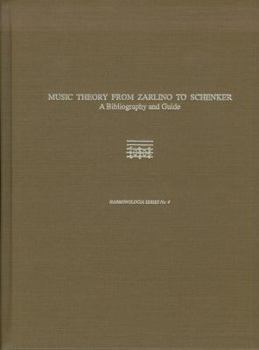Music Theory from Zarlino to Schenker: A Bibliography and Guide
At last a vast amount of recent scholarship, pertaining to four centuries of theoretical developments including the Baroque, Classical, and Romantic periods, has been organized systematically in a... This description may be from another edition of this product.
Format:Hardcover
Language:English
ISBN:0918728991
ISBN13:9780918728999
Release Date:April 1991
Publisher:Pendragon Press
Length:560 Pages
Weight:4.30 lbs.
Dimensions:1.7" x 8.7" x 11.1"
Customer Reviews
1 rating
Want to know more about music? This resource can help you find the material on theory you are looki
Published by Thriftbooks.com User , 17 years ago
What does it say about me that I think this is one of the coolest books I have seen in quite a while? If you are passionate about music, especially art music, I think you eventually will want to dig into how it works. This is what music theorists have done over the centuries. While most have found ways to talk systematically about past works, a few have written speculative works talking about possible systems for music making. In any case, once you start down this road you soon learn that there are oceans full of material about music theory. How do you find material on just the right subject for what you are after? When I was studying music theory at the University of Michigan School of Music (now Music, Theater, and Dance), there were graduate courses that surveyed the vast literature and others that focused on the history of music theory (and the pedagogy of it). It was normal to have to write articles on these ancient texts with everyone contributing to a collection. This book is a very nicely done collection of information from the 16th century Italian music theorist Gioseffo Zarlino through the very influential early 20th Century German theorist Heinrich Schenker. So, it doesn't cover theorists from Antiquity or the Middle Ages. Even though Zarlino was hardly the first Renaissance theorist, he was the first to start thinking about the triad and the ways in which vertical structures in music could function and therefore makes a good place to start a collection of materials on theory related to the art music based on harmony as well as counterpoint. This is a rich resource with many helps and useful collections of information. It begins by listing the abbreviations of periodicals, special series, and so forth. There are a lot of abbreviations to know and since you can't really know them all, this list is very helpful to anyone doing research in this area. The authors also provide sections on reports of musicological congress reports and important festschrifts (celebratory collections of articles in honor of a person or event). These are all from the 20th Century and most after the Second World War. The bulk of the book is a "Dictionary of Theorists". This articles give the name, birth year, a short article about the theorist and his work, important editions of those works, and literature about the theorist and his work. There is also a literature supplement listing other works. The Topical Index lets you find a subject such as Inversion, Chordal and find the theorists related to that subject. The chronological indext starts the Glarean in 1516 and lists the theorists and works of that year (i.e. Isagoge in musicen) and takes the reader through articles on subjects published in 1967. Next is a title index, which helps tremendously if you know a work and are trying to find its author. The following name index helps you find not only the theorist, but all the pages in which he or she is mentioned in this book. Like I s





